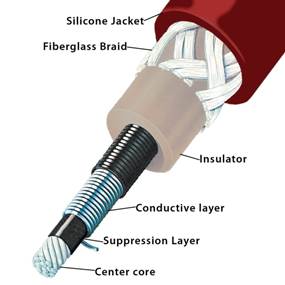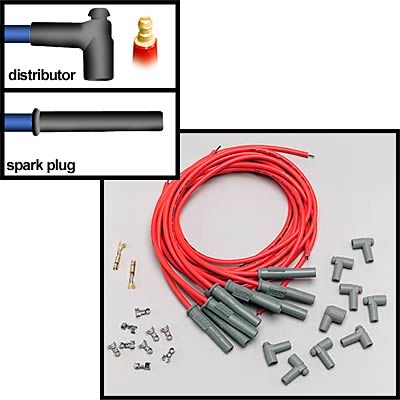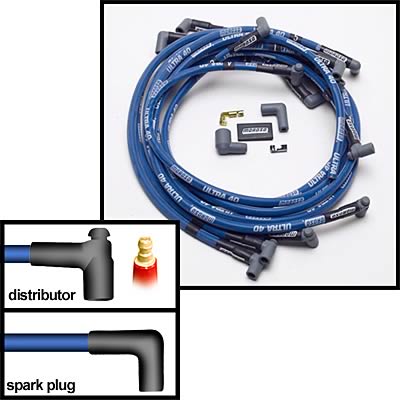Spark plug wires can’t add horsepower (despite what some may claim), but they can adversely affect your vehicle’s performance. That’s why it’s important to select a good quality set of spark plug ignition wires to deliver juice to your spark plugs.
Even though spark plug wires are simple parts (there are absolutely no moving mechanical parts to them), there’s surprisingly little information on the Internet about choosing the right spark plug wires for a given application. We’ll aim to remedy that here by covering the basics of choosing high performance spark wires for your ride.
What makes for a good spark plug wire?
The number one job of any spark plug wire is to transfer an electrical charge from your ignition to your spark plugs. The challenge is to get the maximum amount of this charge to the plugs without creating interference (EMI or RFI) for nearby electrical components. On top of that, the wires must often deal with larger amounts of voltage from modern ignitions and aftermarket ignition coils. Plus, they have to survive in the high temperatures and extreme environment of the engine compartment.
It can be a tall order, but those are the qualifications for a good set of spark plug wires. To fully comprehend the demands put on your spark plug ignition wires, you need to first understand a couple key terms.
Resistance: Rated in ohms-per-foot, resistance is the ignition wire’s tendency to resist the flow of the electric current. Wires with higher ohms-per-foot ratings will allow less current to flow from the spark source to the plugs. This can affect engine performance and fuel economy in a negative way.
Electro-magnetic interference (EMI) or radio frequency interference (RFI): As the higher charges of today’s electronic ignitions are moved through the wires, an electromagnetic field is created around the wire. This field can interfere with sensitive electronic devices and create noise that can be heard through the radio and even affect sensors. This is referred to as EMI or RFI and can wreak havoc, especially in sensitive radio communications.
Some wires are made to produce minimal resistance. Others are designed to suppress EMI. Spark plug wire manufacturers use different core materials and designs to strike the right balance to achieve their desired goal.
Spark Plug Wire Anatomy
 In addition to the all-important core, spark plug wires consist of several different layers. This can vary from manufacturer to manufacture, but a typical wire will consist of a:
In addition to the all-important core, spark plug wires consist of several different layers. This can vary from manufacturer to manufacture, but a typical wire will consist of a:
- Outer jacket: Usually made from silicone, the purpose of this layer is to add strength to the wire and to protect the inner layers from heat, abrasion, chemicals, and other harm inside the engine compartment.
- Braided layer: Usually consisting of a braided fiberglass or similar material, this braided layer is designed to add strength and provide some EMI suppression.
- Insulation: Located below the braided layer, this insulation (usually silicone or similar material) is tasked with protecting the core against heat and minimizing energy loss by preventing the electrical charge from leaking through the outer layers. It also helps contain electromagnetic interference.
- Conductive/suppression layer: Some manufactures add another layer below the insulation as an added safeguard against energy loss or EMI/RFI.
Finally, there’s the core.
The core largely dictates the performance of the spark plug wire. Again, some cores offer low resistance while others provide better EMI/RFI suppression. The most common types of spark plug wire cores are as follows:
Carbon Core: This is the common OEM-style core used on most modern vehicles. It offers excellent RFI suppression but also creates more resistance than other styles. In addition, carbon core breaks down more quickly than other materials so they require relatively frequent replacement.
Solid Core: Solid core spark plug wires typically utilize stainless steel or copper, which conducts electrical current very well. For that reason, solid core wires have lower resistance than other wires to get maximum energy to the plugs. Unfortunately, solid core offers very little EMI/RFI suppression, so they’re not suited for electronic ignition systems or vehicles with sensitive communications equipment.
Spiral Core: Spiral core spark plug wires incorporate an alloy—usually consisting of stainless steel, copper, and tin—wrapping the core to suppress EMI/RFI while maintaining low resistance. As with everything, there is a delicate balance. More wire coils around the core will reduce noise but raise resistance of the wire.
Choosing Your Wire
So which spark plug wire style is right for your vehicle?
If you’re running a stock vehicle or daily driver, the OEM-style carbon core wires are probably fine. Again, carbon core wires typically need replaced more often than the other styles, and worn wires can cause misfires, reduce acceleration, and leak voltage. However, a healthy set of carbon core wires will provide adequate current for stock vehicles without noise or interference.
If you’ve got a vintage hot rod or race car with a carburetor and old-school ignition setup (magneto or points-style), you’d benefit from the ultra-low resistance of solid core wires. In this scenario, the added noise from this style of ignition wire won’t be a factor unless you have an MSD ignition box or like to listen to the radio a lot!
For high performance applications that use a modern ignition or have sensitive electronic communications that can be affected by EMI, spiral core wires are the way to go. Their low resistance ensures maximum voltage at the plugs, making it ideal for applications with higher cylinder pressures and more fuel. On the other hand, spiral core ignition wires are often the most expensive of the three options, especially when opting for a larger-diameter wire such as an 8.5mm-10.4mm. These are most handy in applications using a lot of electronics such as fuel injection, two- and three-step modules, or delay boxes. Simply stated, these larger wires offer a thicker layer of insulation to stop any chances of EMI/RFI that may affect performance.
Spark plug wires are commonly direct-fit to work on a specific application. This makes installation very easy; however, you can also find universal spark plug wires that can be cut to fit. There are also a variety of color options and plug boot configurations (straight, 45-degree, 90-degree, etc.) to fit your particular needs.
It comes down to your application, engine, and individual tastes.








[…] [8] – https://books.google.com/books?id=aS…20core&f=false [9] – How to Choose Spark Plug Wires [10] – Ignition Systems – Basics to High Performance [11] – […]
Thanks I got a 1967 Lincoln Continental with a MSD box what’s the thickset spark plug wire I can use
thanks, i didt know about the disadvantage of carbon cores.
David, I would like to know your recommendation for spark plug wires for the following application.
421 SBC stroker race engine
MSD 6AL off-road ignition
Blaster SS coil
MSD 8750 Distributor
I would prefer larger diameter wires that are sleeved.
Currently using Taylor plug wires. This is for a demolition derby application.
Let me know if you have any questions. Thanks.
[…] first, you have to remember the direction in which your rotor moves. Connect all the remaining spark plug wires one by one, according to the firing order of the repair manual. The firing order is as […]
thanks. informative and straight to the point.
[…] can go to your nearest auto parts store to find and purchase the spark plugs you need for your specific vehicle. Always double-check to make sure that they gave you the […]
Hi David, you advise regarding what ht wire cables is best to use for my cars MGB year 1965 to 1969 and midget 1961, thanks Joe
Hi David, my MGB 1965 is electronic ign lumenition, what ht leads
is suitalble, coil is stnadard, I am having a problem with car,
starts good, ildling good, but after a short run works on 3 plugs
of misfire, thanks Joe.
Thoughts on Granatelli spark plug wires. They claim to offer 5-15 hp with just a wire change.$200+ a set
Hi mate my brothers got a L98 6liter big cam carby set up with msd 61403 ingition the car runs on metheoal would be great if u could help me out with the size and brand of leads
What size spark plug wires should I use?
I need spark plug wires for 272ci YBlock in a 1955 crown Vic, it has the points and condenser now but later I want to add the HEI electronic distributor, can I use the stringer wires now for the points and condenser.. what plug wires u recommend? Thank you Marv
I am building a 523 stroker for my 89 f250 ,. Started with the efi 460 , bored 40 over , got 521 stroker kit ,. Edelbrock. Intake , aluminum heads , 750 carb instead of efi ,. Headers ,. 14mm spark plug threads ,. Need advice on distributor/ coil/wires
Hey Kyle, it’s probably best to click here to contact the Summit Racing tech folks. You can talk through your project with them and they’ll give you a good recommendation for your ignition system.
The coil is basically a transformer or really an inductor. AND inductors discharge is based on the resistance of the path. AND… the higher the resistance, the higher the voltage. SO… low resistance wires are not always your best choice. On copper wires engines,, many time you can pull the plug wire back away from the plug just a little bit, and see the engine speed up. As you increase the resistance via a small gap, the voltage increases dramatically, making it jump the plug gap, with a hotter spark. Thus better combustion on a weak cyl or dirty plug. On newer high voltage systems, this point is mute, but for the older engines out there, copper wires may not be your first choice.
Hi David, I have a 68 mustang with a 302/5.0 engine. I installed a HEI for distributor. What type and size spark plug wires should I install for best performance?
Thank you